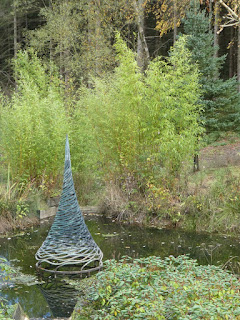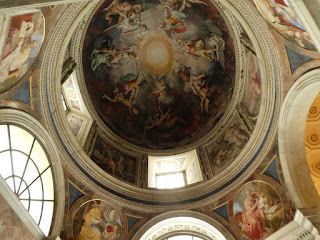Thursday 25th October
The Himalayan Gardens and Sculpture Park at Grewelthorpe are only open for a few weeks in the year. Open countryside suddenly leads to a steep sided hidden valley. The atmosphere is peaceful and there are many paths to choose to explore the garden. Sculptures add to the planting and provide focus and fun. The toadstool is real.
www.himalayangarden.com
Thursday, 25 October 2018
Wednesday, 17 October 2018
Tuesday, 16 October 2018
Wednesday 10th October
We walked through old streets and tiny piazzas in the historic centre, exploring places like the
Galleria Via del Sunari with its fine sculptures and arches.
Just across the street is the Fontana della Tartarughe.
This is one end of the Jewish Quarter where there were lots of restaurants and shops and plenty of places to sit and enjoy the sunshine.
At the end of this street we found Piazza B Cairoli which is surrounded by some very smart properties.
We walked up Via dei Giubbonari which has some interesting buildings and small independent shops.
This led us to Campo de Fiori with its colourful daily market.
We crossed a corner and entered Piazza Novana, the heart of the historic centre.
Musicians and street entertainers give this area a lively atmosphere.
The baroque style Neptune fountain is one of three in this piazza.
We walked up Via G Zanardella to Ponte Umberto I and took a photo of the Palazzo di Giustizia on the other side. Up river we saw boats and floating restaurants and at the next bridge we crossed to the Via de la Corso with its expensive international stores.
The final place we visited was the Piazza del Popolo before getting the metro back to our hotel.
We walked through old streets and tiny piazzas in the historic centre, exploring places like the
Galleria Via del Sunari with its fine sculptures and arches.
Just across the street is the Fontana della Tartarughe.
This is one end of the Jewish Quarter where there were lots of restaurants and shops and plenty of places to sit and enjoy the sunshine.
At the end of this street we found Piazza B Cairoli which is surrounded by some very smart properties.
We walked up Via dei Giubbonari which has some interesting buildings and small independent shops.
This led us to Campo de Fiori with its colourful daily market.
We crossed a corner and entered Piazza Novana, the heart of the historic centre.
Musicians and street entertainers give this area a lively atmosphere.
The baroque style Neptune fountain is one of three in this piazza.
We walked up Via G Zanardella to Ponte Umberto I and took a photo of the Palazzo di Giustizia on the other side. Up river we saw boats and floating restaurants and at the next bridge we crossed to the Via de la Corso with its expensive international stores.
The final place we visited was the Piazza del Popolo before getting the metro back to our hotel.
Tuesday 9th October
At 10am there was hardly any queue at the entrance to the Roman Forum. It is a huge area with mixture of remains. It was a market place, a civic centre and a religious complex. This is the Temple of Antonius and Faustina - AD 141.
This is the temple of the heavenly twins Castor and Pollux after they supposedly led the Romans to victory in 496BC
The Vicus Lugarius is the original road which was created in the 5th & 6th centuries.
The Temple of Saturn was the city treasury with gold, silver and coins stored here.
The Umbilicus Urbis was the notional centre of the city and was also supposedly the place where the living world was in contact with the underworld.
We walked up the most central of Rome's seven hills and explored the Palatine Stadium, an area used by the Emperor for private games
After walking through extensive gardens and ruins, we reached the viewing balcony which gave fantastic views of the Forum and the modern city beyond.
This is the Arch of Titus built by the Emperor Domitian to honour his elder brother Titus.
We caught the Rome Metro to St. Peter's. There were lots of market stalls and vendors and it was a 10 minute walk to the walls of the Vatican City where we saw enormous crowds.
We joined a group for a tour of the Vatican Museum and the first view inside was of St. Peter's Dome.
It was extremely busy inside as the Museum as it would be closed the next day for a Papal audience. The Round Room is centred on this vast red basin made out of a single piece of red porphyry stone.
This gilded bronze statue of Hercules was the only bronze in the Vatican as all the others had been melted down for weapons.
This floor mosaic was exquisite.
The Map Room with its beautiful ceiling is 120 metres long and contains 40 huge topographical maps created between 1580 and 1583 for Pope Gregory XIII.
We were able to snatch a very quick view of the Pope's private garden.
We thought this domed ceiling was wonderful and understand that these rooms were the private apartments for Pope Julius II.
After this we visited the Sistine Chapel and it was amazing but we were not allowed to take photographs of it.
This is the Pope's special door into St. Peter's and it is opened just once a year.
St. Peter's Square was set out between 1656 and 1667 to a design by Bernini. The colonnades represent the motherly arms of the church. The 25m obelisk was brought to Rome by Caligula from Heliopolis in Egypt and was later used by Nero as a turning point for chariot races.
The square was laid out with thousands of chairs for the next day's Papal audience.
As we were leaving we caught sight of these two Swiss Guards, the personal soldiers of the Pope.
At 10am there was hardly any queue at the entrance to the Roman Forum. It is a huge area with mixture of remains. It was a market place, a civic centre and a religious complex. This is the Temple of Antonius and Faustina - AD 141.
This is the temple of the heavenly twins Castor and Pollux after they supposedly led the Romans to victory in 496BC
The Vicus Lugarius is the original road which was created in the 5th & 6th centuries.
The Temple of Saturn was the city treasury with gold, silver and coins stored here.
The Umbilicus Urbis was the notional centre of the city and was also supposedly the place where the living world was in contact with the underworld.
We walked up the most central of Rome's seven hills and explored the Palatine Stadium, an area used by the Emperor for private games
After walking through extensive gardens and ruins, we reached the viewing balcony which gave fantastic views of the Forum and the modern city beyond.
This is the Arch of Titus built by the Emperor Domitian to honour his elder brother Titus.
We caught the Rome Metro to St. Peter's. There were lots of market stalls and vendors and it was a 10 minute walk to the walls of the Vatican City where we saw enormous crowds.
We joined a group for a tour of the Vatican Museum and the first view inside was of St. Peter's Dome.
It was extremely busy inside as the Museum as it would be closed the next day for a Papal audience. The Round Room is centred on this vast red basin made out of a single piece of red porphyry stone.
This gilded bronze statue of Hercules was the only bronze in the Vatican as all the others had been melted down for weapons.
This floor mosaic was exquisite.
The Map Room with its beautiful ceiling is 120 metres long and contains 40 huge topographical maps created between 1580 and 1583 for Pope Gregory XIII.
We were able to snatch a very quick view of the Pope's private garden.
We thought this domed ceiling was wonderful and understand that these rooms were the private apartments for Pope Julius II.
After this we visited the Sistine Chapel and it was amazing but we were not allowed to take photographs of it.
This is the Pope's special door into St. Peter's and it is opened just once a year.
St. Peter's Square was set out between 1656 and 1667 to a design by Bernini. The colonnades represent the motherly arms of the church. The 25m obelisk was brought to Rome by Caligula from Heliopolis in Egypt and was later used by Nero as a turning point for chariot races.
The square was laid out with thousands of chairs for the next day's Papal audience.
As we were leaving we caught sight of these two Swiss Guards, the personal soldiers of the Pope.
Sunday, 14 October 2018
Monday 8th October
There were huge queues at the Colosseum so we walked past it to the Circus Maximus which was ancient Rome's largest chariot race track, a 250 thousand seater capable of holding a quarter of the city's population. This is only a small segment of the original stadium which has recently opened after 6 years of restoration.
The main part of the stadium had been used at the previous weekend for a Roman version of the Yorkshire show.
We walked along the bank of the Tiber to Ponte Sublicio which was a peaceful contrast to the earlier crowds.
The next bridge we reached was Ponte Palatino where we had a good view of Isola Tiberina. This is one of the world's smallest inhabited islands and has a hospital on it today.
We explored some of the smart cafes and shops on Via del Corso, then stopped at Galleria Sciarra with its lovely Art Nouveau painted walls and glass roof
Nearby is the Trevi Fountain which is enormous in quite a small square and the crowds here were overwhelming.
More interesting streets led us to the Spanish Steps which was in large square and was not too crowded.
We were able to relax by the fountain in the shade.
Refreshed by delicious gelatos, we returned to the Colosseum in the late afternoon. It was not too crowded and the sun gave fantastic shadows, adding to the drama of this awesome building.
There were huge queues at the Colosseum so we walked past it to the Circus Maximus which was ancient Rome's largest chariot race track, a 250 thousand seater capable of holding a quarter of the city's population. This is only a small segment of the original stadium which has recently opened after 6 years of restoration.
The main part of the stadium had been used at the previous weekend for a Roman version of the Yorkshire show.
We walked along the bank of the Tiber to Ponte Sublicio which was a peaceful contrast to the earlier crowds.
The next bridge we reached was Ponte Palatino where we had a good view of Isola Tiberina. This is one of the world's smallest inhabited islands and has a hospital on it today.
We explored some of the smart cafes and shops on Via del Corso, then stopped at Galleria Sciarra with its lovely Art Nouveau painted walls and glass roof
Nearby is the Trevi Fountain which is enormous in quite a small square and the crowds here were overwhelming.
More interesting streets led us to the Spanish Steps which was in large square and was not too crowded.
We were able to relax by the fountain in the shade.
Refreshed by delicious gelatos, we returned to the Colosseum in the late afternoon. It was not too crowded and the sun gave fantastic shadows, adding to the drama of this awesome building.
Subscribe to:
Comments (Atom)




























































